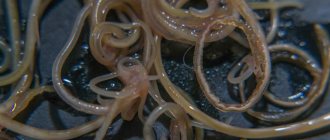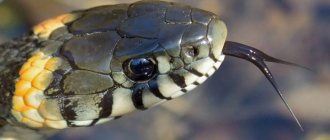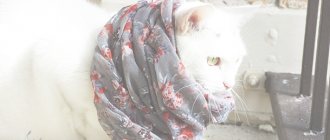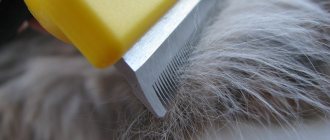Trichodectosis is a disease of domestic cats caused by infection of the animal with lice, often referred to in everyday life as lice.
This type of infestation is a less common variant of a cat becoming infected with parasites than the appearance of fleas. Cat lice are distinguished by a number of interesting features, including the specificity of their diet.
Unlike other parasites, these insects do not feed on the blood of the animal, preferring the cat's fur, as well as the upper layers of the skin. However, the manifestations of trichodectosis are typical for other forms of parasitic infestations.
The animal is bothered by severe itching, appetite and sleep are disturbed. Also, lice and lice eggs are potential sources of various infectious diseases and helminthiasis. How to protect an animal from infection and remove parasites if they have already appeared? Let's talk about this in more detail.
Do cats have lice?
As noted above, lice in cats are a fairly rare form of parasitic infestation. Much more often, the animal is attacked by other, no less unpleasant insects called fleas. Unlike several other types of lice, for example, human or rat, cat parasites are characterized by low resistance to the negative effects of external factors.
These insects cannot exist outside the host's body. Due to this feature, lice infection occurs exclusively through close contact between an infected and a healthy individual. In addition, lice are slow to move and cannot jump or run.
What do cat lice look like?
Lice that live on a cat's fur are small insects whose size does not exceed 3 mm. They have an oblong body and a light beige transparent color. The head is quadrangular, much larger than the chest. In its front part there is a special recess, which, in addition to the paws, helps them stay on the hair.
The insect has three pairs of legs. The cat louse navigates in space using olfactory receptors, which are located on the antennae in the front of the head.
Can cat parasites be transmitted to humans?
Probably, almost every owner of an infected pet is interested in this kind of question - can lice pass from a person to a cat. These parasitic insects are specific, that is, their invasion of humans is not possible. A pet can be a carrier of lice, but an infected animal is only dangerous to members of its own species.
Are cat lice dangerous for humans?
Lice can live on cats for quite a long time - under favorable conditions, they do not leave the infected animal throughout its entire life, the total duration of which is no more than a month. Despite the fact that lice of this species cannot parasitize humans, they are potentially dangerous to humans. The danger lies in the risk of contracting infectious diseases or helminthiasis, which are carried by parasite eggs.
Description of the disease
A cat infested with lice (pediculosis) often develops as a result of the animal being infected with fleas.
Lice are inactive in the initial stages of parasitism and are difficult to detect. Lice feed on the keratinized scales of a cat's skin. They do not drink the blood of the “host”, unlike parasites that live on humans.
Lice multiply quickly. The female lays 50–70 eggs per day. The life cycle of the insect is 20-25 days.
If treatment of a cat is not started on time, it can lead to baldness of the animal. Lice carry helminth eggs and are capable of infecting the “host” with them.
Insects living on cats are not transmitted to humans or other pets. Just like a human or canine parasite will not survive on a cat.
Peaks of lice infestation occur in the autumn-winter period, when animals have a thick undercoat. In spring and summer, the parasite population decreases.
The only cat breeds that are not infested with lice are hairless. Insects have nothing to attach themselves to.
How to recognize lice on a cat
Cat lice are small in size and lighter in color than fleas. To determine whether a cat has lice, it is enough to observe the behavior of the animal. If it behaves restlessly, shows anxiety due to severe itching, it is necessary to examine the animal’s fur and skin. If there are small yellowish parasites, scratches, or small wounds on them, it is necessary to begin treatment immediately.
More about cat lice
Sedentary parasites that live in the fur of cats are usually called lice eaters. They, unlike their counterparts, extremely rarely feed on blood, specializing in the upper exfoliating layers of skin and fur. Only in rare cases do cat lice feed on blood on wounds and abrasions. Lice eaters are not capable of biting a pet and sucking its blood, as lice do on humans.
Methods for getting rid of lice and nits
So, if a cat has lice, how to get rid of these unpleasant parasites, what to do if infected?
Treatment at home is carried out through the use of various insecticides that have a detrimental effect on adult parasites and eggs. When choosing the most suitable active ingredient, it is recommended to take into account factors such as age and degree of infection. If there are other parasites, for example, lice, comprehensive treatment should be carried out.
Emulsoids
To remove parasites from cats, it is recommended to use various types of emulsoids. Products in this group for the treatment of head lice in cats are intended for diluting the concentrate in water and then applying it to the animal’s fur. The drug is quickly absorbed into the skin. When the parasite comes into contact with this substance, the insect dies.
A significant disadvantage of lice emulsoids is their high toxicity and potential danger to the animal. Contact of insecticides with the eyes, skin, or oral cavity can cause acute intoxication of the animal. In addition, such drugs remain effective for a limited period of time.
Drops and sprays
To remove adult individuals and nits from cats, you can use various drops and sprays that have somewhat similar effects. Lice drops for cats, for example, are intended to be applied to the withers area. They are almost instantly absorbed into the skin and retain their toxic effect for several months. When processing, you should strictly monitor the area where the drug is applied, since licking off the drops may result in acute poisoning.
Anti-lice sprays are also designed to treat hair in the area of the withers and spinal column. Aerosol medications are essentially improved emulsoids. Unlike the latter, sprays remain effective for several months. Due to the specific nature of the treatment, the risk of poisoning is extremely low.
Collars and shampoos
If a kitten has lice, it is recommended to remove them by using shampoos. These products are particularly gentle and non-toxic. Their significant drawback is the lack of a prolonged, destructive effect on parasites. The components included in their composition repel lice, but the risk of re-infestation cannot be excluded.
To prevent infection of your pet and eliminate existing lice, it is recommended to use special collars made from materials that contain various insecticides. As a rule, the use of collars is recommended for the treatment of pets whose age is more than two months. The device must be changed periodically due to the fact that the active components lose their effect.
Treatment of dermatitis
The cat louse feeds on hairs and particles of the animal's skin, which causes severe itching. When scratching itchy areas, the animal introduces infection into existing wounds, which leads to the development of inflammation and dermatitis. If your cat has lice or small ulcers appear on the skin, treatment should be started immediately.
The main methods are the following:
- the use of anti-inflammatory drugs that prevent the spread of pathological processes and help eliminate them.
- Antiseptics. They should be used to provide a disinfecting effect.
- Antimycotic.
- Healing. They should be used to stimulate the regenerative abilities of tissues and more quickly restore the skin.
It is recommended to comprehensively use products that help eliminate pain and itching. This measure will help improve the condition of the animal.
Treatment
Having figured out whether lice live on cats and how to recognize them, you should move on to those measures that will help get rid of parasites quickly and safely. A set of therapeutic procedures is aimed at destroying lice and combating signs of dermatitis. It is necessary to select all medications in consultation with a veterinarian, because only he, based on an examination, can prescribe a truly effective drug.
There are nuances that need to be remembered when processing the skin and fur of a cat:
- do not exceed the maximum permissible dosage of the drug;
- ensure that the treated areas are inaccessible to the pet, since ingestion of a number of drugs can cause acute poisoning;
- The pet may have an individual intolerance to the drug, which is why if the cat’s condition worsens after contact with the miracle drug, it is necessary to immediately stop using it.
And, of course, the fight against parasites must be comprehensive - only in this case will it be possible to achieve maximum results.
Shampoos
Modern shampoos against parasites contain insecticides that repel insects, including lice. They paralyze their nervous system and respiratory organs. In addition to toxic substances, they are enriched with caring and softening components that help moisturize the pet’s skin and heal wounds.
Natural ingredients most often act as insecticides: essential oils, extracts and extracts of medicinal plants. The quality of shampoo is determined by the proportional ratio of toxic and caring components.
Using anti-lice shampoo is quite simple, but it is better to bathe your pet following the instructions from the manufacturer. Here are the main recommendations:
- use a separate bath or basin;
- fill it with warm water and immerse the animal there;
- Gently pour water over the wool and treat it with shampoo;
- leave for 7-10 minutes, then rinse the shampoo with water.
Most often, in order to get rid of parasites, one procedure is enough; in advanced situations, you will have to repeat it 2-3 more times. When choosing a shampoo, you should take into account the age of the animal, as well as the spectrum of action. The most popular anti-lice shampoos for cats today are:
- BioVax is a product whose composition includes extracts of medicinal plants. Famous for being suitable even for kittens and pregnant cats. The product is concentrated, so before use you should dissolve one capful of the product in a liter of water, then beat it until it forms a dense foam. It is she who should treat the pet's fur.
- Ms Kiss is a shampoo developed in a Swiss laboratory. The permethrin present in the composition kills parasites after the first use, and the conditioner softens its effect on the pet’s irritated skin. A convenient dispenser ensures economical use of the product. Suitable for kittens from 4 months.
- Celandine is one of the most budget options. The product of the Russian version contains the same permethrin, as well as aloe extract and B vitamins. The shampoo is contraindicated for individuals under 8 months, as well as pregnant and lactating females; you should be careful with dosages, strictly following the instructions. At the same time, the shampoo shows excellent results - as a rule, just one bath is enough to get rid of lice.
- Bio-Groom is an American shampoo, the composition of which includes plant and synthetic ingredients. Before use, dilute 1 part of the product in 4 parts of water, and then treat the animal’s hair with the resulting solution. After leaving for 5-7 minutes, rinse off the shampoo and comb the coat with a special comb.
Sprays
Spray is another form of the drug with insecticides, quite convenient to use. The product is sprayed onto the animal's fur near the withers and does not require rinsing. The spray retains its effect for several months, and the specifics of its use make it one of the safest products for pets.
If swimming is impossible, the spray will be a real salvation, you just need to follow a number of recommendations:
- Avoid swimming a few days before treatment;
- use a special collar to prevent the drug from being licked from the fur;
- Carry out the procedure in the fresh air, carefully treating all areas;
- after the product has dried, comb the animal’s fur to rid it of all parasites and nits;
- Avoid swimming for the next 2-3 days;
- Repeated treatment is allowed only after 1-2 weeks.
When choosing a spray for your pet, we advise you to pay attention to the most popular drugs:
- Barrier Bolfo is a fairly popular product based on propoxur. An absolutely hypoallergenic product that allows you to treat not only your cat’s fur, but also its household items. But not suitable for kittens under 3 months, as well as pregnant individuals.
- Sentry - the composition of the product is enriched with natural essential oils, and it is precisely due to its pungent odor that it repels insects. In order to get rid of parasites, several treatments are enough; for prevention, it is recommended to treat the cat’s fur throughout the year with breaks of 2-3 weeks. The product is contraindicated in kittens under one year of age.
- Fiprist is an excellent product suitable for kittens from 1 week of age. Fipronil, which is enriched in the composition, perfectly fights various parasites that live in the fur of domestic animals. After treatment, the protective effect will continue for another 2-3 months.
Drops
To remove lice and nits, drops are often used, intended for application to the withers area. Instant absorption, prolonged action, effectiveness and ease of use - this is the secret of popularity. The only thing is that you need to monitor the treatment area, eliminating the possibility of the animal licking the drug from the fur.
The most popular are:
- Bars - drops based on fipronil in minimal concentration. The mild action allows the product to be used even by kittens from 10 months. Due to the strong odor of the active components of the drug, it demonstrates a repellent effect on parasites.
- Hartz Ultra Guard is an American product based on methoprene, available in several types for different ages and coat lengths. The manufacturer promises that the insects will die on the first day after treatment. The only caveat is that kittens under 10 months are not allowed to use the product.
Collars
The collar is a convenient and safe means of combating parasites, suitable for kittens from birth. It also repels lice due to its pungent odor and toxic components with which it is impregnated. It is affordable, easy to use and quite effective.
Before purchasing, you need to measure the circumference of your pet’s neck, make sure that the proposed option is suitable for cats, and that there are no components that can cause an allergic reaction in the animal.
Rules for removing lice from cats
If an animal has cat lice, antiparasitic treatment must be carried out following certain rules. First of all, it is important to exclude the possibility of contact of the animal with a toxic substance. To do this, you can put a special restrictive collar around the cat's neck. Otherwise, the necessary actions are prescribed in the instructions for the selected drug.
It is important to remember that some insecticides do not have a detrimental effect on parasite eggs, which are protected by a dense capsule.
Accordingly, to prevent the reappearance of insects, it is necessary to carry out additional treatment of the cat two weeks after the first procedure.
How harmful are lice to a cat?
The appearance of lice in a cat is fraught with the development of dangerous consequences for the animal. Severe itching provokes cat anxiety, lack of appetite, and sleep disturbances. When an animal scratches itchy areas, an infection may occur, which can cause inflammation and the appearance of wounds. Against the background of a significant number of parasites, the cat’s hair loss occurs, up to complete baldness.
Lice are especially dangerous in kittens. Infection with these parasites can cause the death of the animal. The main factor that can lead to such unfavorable consequences is the infection of the cat with various types of helminths, the carriers of which are lice. Infection occurs when eggs or adult parasites enter the animal's digestive tract.
Prevention
After treating a cat for lice, it is important to resort to preventive measures that will somewhat reduce the likelihood of the animal becoming infected in the future. This requires the use of anti-parasitic collars, which are important to change as needed.
The state of health of the skin is important. Healthy, clean skin, free from scratches and wounds, prevents the rapid proliferation of parasites. To keep your pet healthy, you need to feed it a balanced diet, avoid contact with infected pets, and conduct periodic coat checks.
The main sign that indicates a lice infestation is the appearance of whitish nits and dark spots on the skin and fur, which are products of the vital activity of parasites.
Even if their number is insignificant, it is necessary to immediately take measures aimed at destroying lice.










